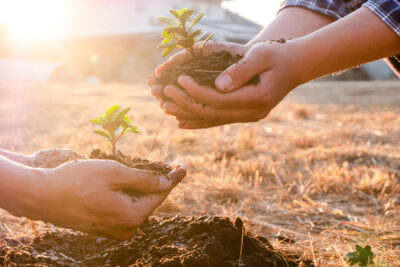
As environmental concerns become increasingly prominent, more individuals and communities are shifting toward landscaping practices that promote sustainability and ecological harmony. Bare root trees and shrubs represent an excellent choice for environmentally conscious landscaping, offering significant benefits in terms of resource efficiency, adaptability, and ecosystem support. In this article, we’ll explore how using bare root plants can help homeowners and businesses alike achieve beautiful, sustainable landscapes.
Advantages of Bare Root Plants
Bare root trees and shrubs, harvested in a dormant state without attached soil, offer several key advantages that align with sustainable gardening principles:
Cost and Resource Efficiency Transporting bare root plants is more energy-efficient compared to container-grown alternatives, primarily due to their reduced weight and minimal packaging. This lowers shipping costs and significantly decreases the carbon footprint associated with distribution.
Improved Growth and Survival Rates Bare root plants typically establish themselves faster and healthier because their roots directly interface with the local soil environment. This adaptation reduces transplant shock, leading to stronger, more resilient plants that require fewer resources, especially water.
Promoting Environmental Sustainability
Integrating bare root trees and shrubs into landscaping projects yields numerous ecological benefits:
Water Conservation Bare root plants quickly develop extensive root systems capable of efficiently absorbing water, significantly reducing the need for supplemental irrigation. Coupled with sustainable watering methods like drip irrigation or soaker hoses, bare root plants drastically lower overall water consumption.
Enhanced Soil Quality Bare root planting helps maintain and enhance soil health naturally. Robust root systems aerate the soil, improving its structure and fostering microbial life, which boosts fertility without reliance on chemical fertilizers.
Reduced Dependency on Chemicals Selecting native and regionally adapted bare root species greatly reduces the need for chemical pesticides and fertilizers. Native plants have evolved to withstand local pests and diseases, further minimizing environmental impacts.
Boosting Biodiversity Bare root landscaping supports local wildlife by providing essential habitats and food sources. Native trees and shrubs attract beneficial insects, birds, and other wildlife, strengthening ecological balance.
Carbon Capture Trees and shrubs play a pivotal role in mitigating climate change by capturing atmospheric carbon dioxide. Sustainable landscaping practices with bare root plants amplify this effect, sequestering significant amounts of carbon in vegetation and soils.
Key Sustainable Landscaping Techniques
Implementing sustainable landscaping with bare root plants involves several best practices:
Choosing Suitable Plants Select native or well-adapted species tailored to your local climate and soil conditions. These plants naturally thrive, requiring minimal care, fewer resources, and no artificial interventions.
Proper Planting Methods Before planting, rehydrate bare root plants by soaking roots in water. Dig spacious holes that comfortably accommodate the root systems, then backfill gently with original soil. Ensure soil isn’t overly compacted to maintain aeration and optimal root development.
Mulching for Sustainability Applying organic mulch around new plants preserves moisture, reduces weed growth, regulates soil temperature, and adds nutrients back into the soil, creating an ideal growing environment.
Efficient Irrigation Practices Adopt precise irrigation techniques such as drip irrigation or soaker hoses to deliver water directly to plant roots. Schedule watering during cooler hours to minimize evaporation and maximize efficiency.
Natural Maintenance Commit to organic gardening practices by using compost and natural pest management strategies instead of synthetic fertilizers and pesticides. Monitor plants regularly, addressing potential issues promptly with eco-friendly solutions.
Design for Wildlife Plan your landscape design to incorporate flowering and fruit-bearing bare root plants that attract pollinators and beneficial wildlife. Allowing certain areas to grow naturally provides vital habitat diversity.
Case Example: Transforming Community Landscapes
Consider a community garden initially reliant on chemical inputs, extensive watering, and non-native plants. Transitioning to sustainable landscaping using bare root trees like maples and birches, along with native shrubs such as serviceberries and spicebushes, transformed the garden into a thriving ecosystem. Reduced water use and the elimination of harmful chemicals encouraged rapid establishment and flourishing biodiversity, attracting pollinators, birds, and beneficial insects.
Long-Term Sustainability Benefits
Sustainable landscaping with bare root trees and shrubs offers extensive long-term advantages:
- Reduced maintenance and operational costs due to lower water and chemical usage.
- Increased aesthetic appeal and enhanced property values.
- Improved landscape resilience against climate stressors, pests, and diseases.
- Positive ecological impact through enhanced biodiversity, improved soil health, and substantial carbon sequestration.
Bare root trees and shrubs are instrumental in achieving sustainable landscaping objectives. By embracing these practices, gardeners and landscapers can foster healthier environments, conserve essential resources, and enjoy lasting beauty in their outdoor spaces. Adopting sustainable landscaping methods with bare root plants represents a meaningful commitment to environmental stewardship and ecological responsibility.
Contact Cold Stream Farm at (231) 464-5809 today or visit us online for more information!
